
The mythological history of the universe, the world, and the gods is known to us best from a poem entitled the Theogony by the poet Hesiod, who lived ca. 700 BC. In this poem he told how Chaos existed before all else, but spontaneously generated Gaea (the Earth), Tartarus (the Underworld) and Eros (sexual desire). It is not too surprising that because such an abstract concept is difficult to convey in a picture, we do not find illustrations of the beginning of everything.
What we do find are depictions of the next generation of beings, the descendants of Gaea (Earth) and her own son Uranus (the Sky), whose most important children are known as the Titans. Two of these Titans (Hyperion and Theia) produced an important group of children. They are Selene (the Moon), Helios (the Sun), and Eos (the Dawn, known as Aurora to the Romans). It is also worth noting here that Helios later became identified with Apollo, and Selene with Apollo's sister Artemis (Diana), both of whom are featured in other sections (Apollo in Section 6, Artemis in Section 5).
Contents
The first of the three siblings to be covered, Selene is seen here first in a red-figure vase-paintingdriving her chariot across the sky. Note the symbol of the moon-disc on her head. The second image is an elaborately carved Roman sarcophagus which features as its main scene the tragic love between Selene and Endymion, a handsome mortal.

Red Figure
As Selene was immortal, she wanted a way to keep Endymion as he was forever. The only option was for him to be eternally asleep. Anibale Carracci included this pair among the many scenes in the Farnese Gallery in Rome (ca. 1600).

Carracci
Nicholas Poussin (ca. 1630) chose a somewhat different approach and shows Endymion before he is eternally asleep (but note the sleeping figure in the background, a clue to Endymion's fate).

Nicholas Poussin
Ubaldo Gandolfi gave the scene a real sense of etheral beauty (ca. 1770).

Ubaldo Gandolfi
Eos, goddess of the dawn, has the job of preceding her brother the sun each day, spreading the dew found on the ground in the morning. The first image below, a huge fresco from the Palazzo Pallavicini, Rome, is a masterpiece by Guido Reni, done in 1614. The dawn-goddess appears on the right, preceding her brother Helios with his attendants on the left.
Guido Reni
The next image is a simple portrait of Eos holding her pitchers of dew on a red-figure vase painting.

Red Figure 1
The next two images depict the tragic love affair between the goddess and a mortal man named Tithonus, a story which is very similar to that of Selene and Endymion, but with a different outcome. Like her sister, Eos sought the gift of eternal life for her lover, but she neglected to ask for eternal youth. Thus Tithonus lived on and on but he got older and older, while she remained young and beautiful. Some say Tithonus eventually shrivelled up and disappeared, or was transformed into a cicada. The second red-figure vase painting below shows Eos pursuing Tithonus. The painting by Sebastiano Ricci (ca. 1700) depicts the still-young goddess above the elderly Tithonus below.

Red Figure 2

Sebastiano Ricci
Helios, the brother of Selene and Eos, has the daily duty of driving the fiery chariot of the sun across the sky, seen first in two ancient images, a red-figure vase painting of Helios in his chariot (note the rays of the sun emanating from his head) while the second is a Roman mosaic showing him in an almost identical pose.

Red-Figure

Mosaic
The next two paintings are from the 1600s, by Poussin and Reni.

Poussin
Guido Reni
Then one more Baroque version, by Charles de la Fosse, late 1600s.
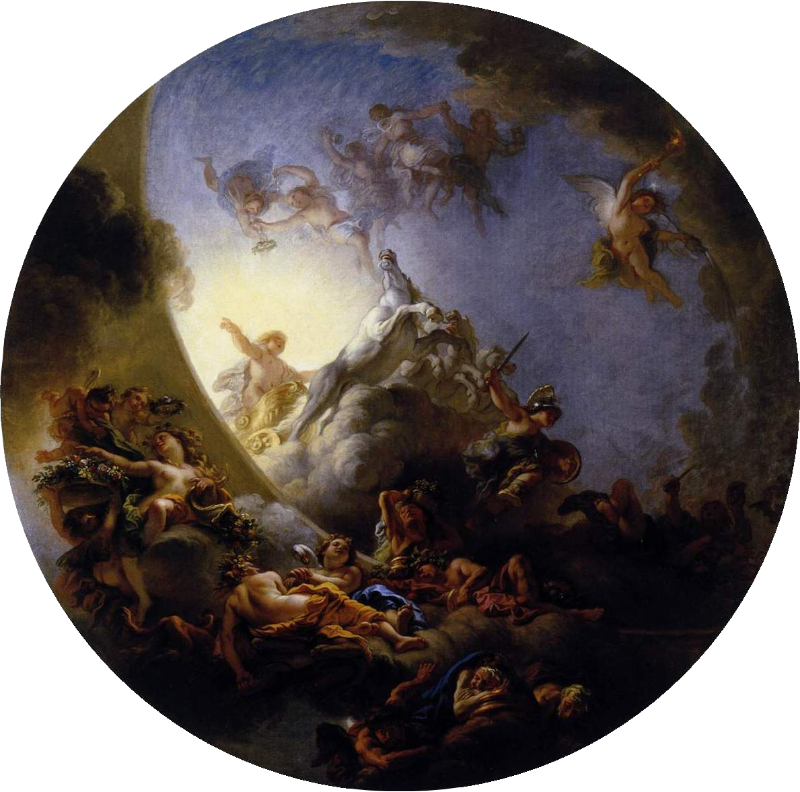
Charles de la Fosse
Here are three illustrations which attempt to recreate the appearance of the Colossus of Rhodes, a gigantic bronze statue of Helios which was rated as one of the famous Seven Wonders of the World. The statue was about 100 feet tall, roughly the same size as the Statue of Liberty, and stood close to the harbor of Rhodes (but not straddling the entrance, as some people once believed, pictured below). It took 12 years to complete (292-280 B.C.), and was a engineering marvel for its time. Unfortunately, it only stood for 56 years, having toppled during an earthquake in 224 B.C.

Incorrect
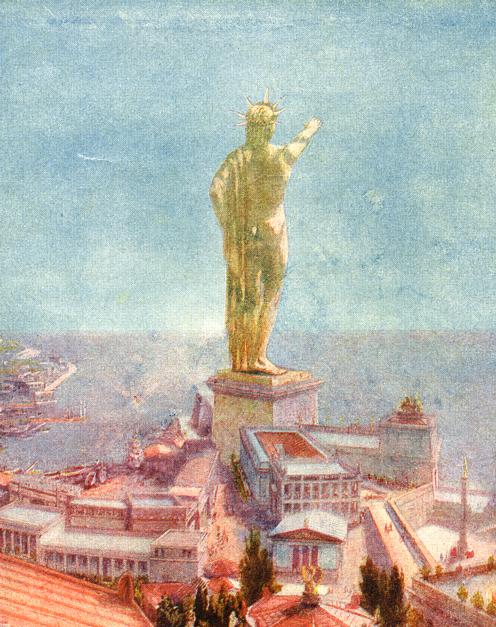
Back

Front
Helios had a son named Phaëthon with a daughter of Oceanus the Titan, although they did not live together. Nevertheless, when Phaëthon had grown older, his mother told him who his true father was, and the boy went to Helios to introduce himself. In his joy at meeting his son, Helios was persuaded to allow him to drive the sun-chariot the next day, although he tried to convince Phaëthon that it was more difficult than it appeared, and advised against it. But he had given his word to grant the boy's request, no matter what, so he reluctantly allowed Phaëthon to drive the chariot the next day. Sure enough, the boy could not control the fiery horses, and they began to run wild, off course. Zeus, angered at this, blasted Phaëthon from the chariot, and he fell to his death on the earth below.
The first view of the scene is a finished drawing by Michelangelo.

Michelangelo
Next is a huge dramatic painting by Sebastiano Ricci.

Sebastiano Ricci
The third version is by Gustave Moreau, a 19th Century artist whose work will be seen many more times in upcoming sections. One aspect of Moreau's style is evident here, namely that he frequently deviates from the conventional depictions of the myths. Here he symbolizes the power of Zeus in the form of a golden lion, which is not a traditional image, but Moreau apparently wanted it so. Also new to the scene is the serpent attacking him from the lower right, presumably as a symbol of mother Earth, who was being scorched.

Gustave Moreau
As mentioned above, Gaea and Uranus were the parents of the Titans, but there were other offspring of this couple as well: the Cyclopes and the Hecatoncheires, who were despised by their father. He would not allow them to be born from Gaea's womb, which caused her great distress. She turned to the Titans and asked if any of them would oppose Uranus. The youngest and wiliest Titan, Cronus, volunteered. Gaea armed him with a sickle, which he used to castrate his father, robbing him of his power to rule. The Cyclopes and the Hecatoncheires could now be born, and Cronus now reigned as the supreme god.
Here are two versions of this scene. The first is a mural by Giorgio Vasari at the Palazzo Vecchio (Ducal palace) in Florence. Vasari is more remembered today for his detailed biographies of Renaissance artists than for his own paintings. Note here the dome of the sky in the background (since Uranus is the god of the heavens).

Vasari
The other image is a drawing copied from a red-figure vase-painting which has several interesting details: Cronus is seen with a pair of wings (not normal for him), sickle in one hand, (dripping blood which creates the Furies, in the lower right). Cronus has apparently already done his bloody deed, but is finishing Uranus off in this superhero-like pose, complete with a starred 'punch'-effect. Also visible are the Cyclopes (the ones with one eye) and the Hecatoncheires (the ones with multiple heads and limbs) on the left and Gaea herself watching on the right.
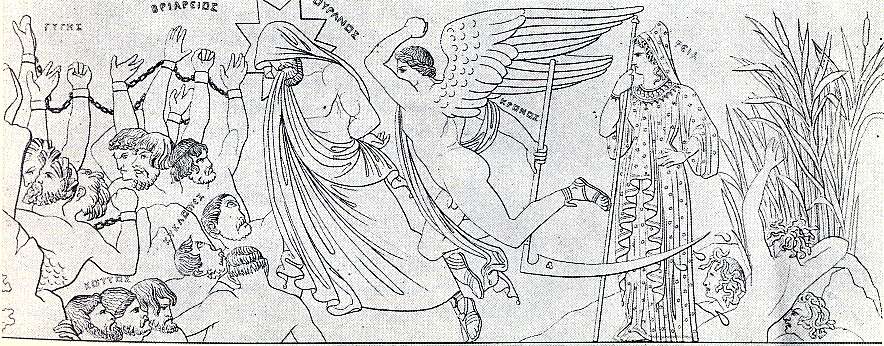
Vase Painting facsimile
When Uranus was castrated by Cronus, the severed genitals were thrown into the sea, where the water began to bubble and foam, and from this foaming sea arose Aphrodite (her name apparently deriving from the Greek word "aphros", meaning foam), the goddess of love, beauty and sexuality.
[Note: Aphrodite is covered in more detail in Section 4, but we mention her birth here as an important part of the story of the Titans.]
The first depiction of this episode is seen below as the main panel of a sculpted seat or 'throne', and is named for the collection to which it now belongs. The exact date and place of its creation are unknown, but on stylistic grounds, historians have assigned it to a date of around 460 B.C. Somehow this work of Greek art found its way to Rome, where it was on display in the famous Gardens of Sallust, an important Roman historian who lived between 86-35 B.C., the time of Julius Caesar and Cicero.

Ludovisi 1
Besides the time and place of manufacture, there is much else that is uncertain about this piece, for its function is not known exactly. Some believe perhaps it was a ceremonial chair for a priest or priestess, while others suggest it may have been a pedestal for the seated statue of a god or goddess, now missing.
Also mysterious is the significance of the two females on the two sides panels: one shows a naked flute-playing young woman (a sort of activity associated with revelry), while on the opposite side is a woman fully dressed, possibly a priestess, putting incense into a burner. The two seem to be at opposite ends of womanhood: one appears loose and fun-loving, the other serious and sober, yet somehow both are linked by Aphrodite.

Ludovisi 2
The third view shows the Ludovisi throne from an angle.

Ludovisi 3
The next part of the story is perhaps the most gruesome. Having been warned by his father Uranus that one day one of his children would defeat him, Cronus (Saturn) decided to try to prevent this by forcing his wife (and sister) Rhea to hand over any children she produced, whom he then swallowed. We see this gory scene first in a painting by Rubens, followed by an even more violent version by the Spanish artist Francisco Goya.

Rubens

Goya
Eventually Rhea came up with a plan: when her sixth child was born, she hid the infant and handed Cronus a rock wrapped in blankets, which he immediately gulped down, unaware of the substitution. We see this scene in two very similar examples. First, a red-figure vase painting.

Red Figure
A metope from Selinus, a Roman-era work done in the Classical style.
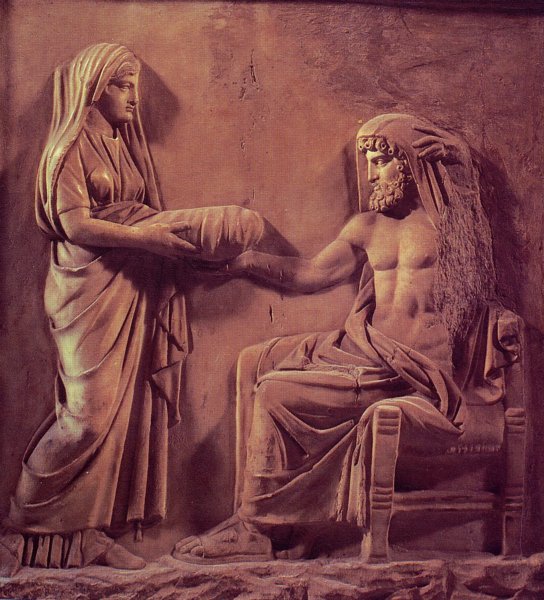
Metope
This sixth child was Zeus (Jupiter). Saved by his mother and hidden on the island of Crete, little Zeus was said to have been nursed by a she-goat named Amalthea. Here we see them (along with a young satyr) in a sculpture by Gian Lorenzo Bernini. It is thought by some that the date of this work is 1609—when Bernini was only 11 years old!

Bernini
After he had grown up, Zeus did indeed defeat and replace his father Cronus, just as Uranus had predicted.
During the Hellenistic era, Pergamum (also spelled Pergamon) was a major Greek city on the coast of Asia Minor (present day Turkey). It split off as an independent city-state in 283 B.C., and for the next 150 years (until it was taken over by the Romans in 133) was a city of the first rank (see the museum model below). The most notable of the Hellenistic rulers was named Eumenes II (from 197 to 159 B.C.), under whom a library was founded which rivalled the more famous one at Alexandria. In 166 B.C. Eumenes defeated the Gauls of nearby Galatia, and it is possible that the Great Altar pictured below was constructed in honor of this victory.
The Great Altar of Zeus is an almost-square structure, 119.5 feet wide, 114 feet deep, and 40 feet tall.The west side had the main stairway (66 feet wide) leading to the altar itself. Surrounding the structure on all sides (except where interrupted by the stairs) is a continuous frieze, 8 feet tall, depicting the great battle between Zeus and the other gods versus the Giants, the offspring of Mother Earth (Gaea).

Peramum Model
The sculptures were discovered in 1864 by a German engineer/amateur archaeologist named Carl Humann, who supervised the first excavation of the site in 1878. Eventually fragments of about 80 separate figures were found (many badly damaged), although originally there were probably about 100 figures. In 1930, one side of the altar was reconstructed and put on display at the Pergamum Museum in Berlin, along with the other surviving fragments.

Altar in Berlin
The sculptures of the altar display an energy and vitality that are typical of the Hellenistic period. The first close-up is one of the best preserved panels, showing the goddess Athena gripping a fallen giant by the hair. You can also see the form of Gaea, rising from the earth (because she is the earth). Note how the Giant is stretching his leg out to touch his mother, perhaps to draw strength from her.

Athena vs. Giant
A close-up shows the Giant seen in the previous image.

Giant
In another detail, we see another fallen Giant, being attacked by the dog of Artemis (whose lower leg is on the right, with an ornately-decorated sandal).
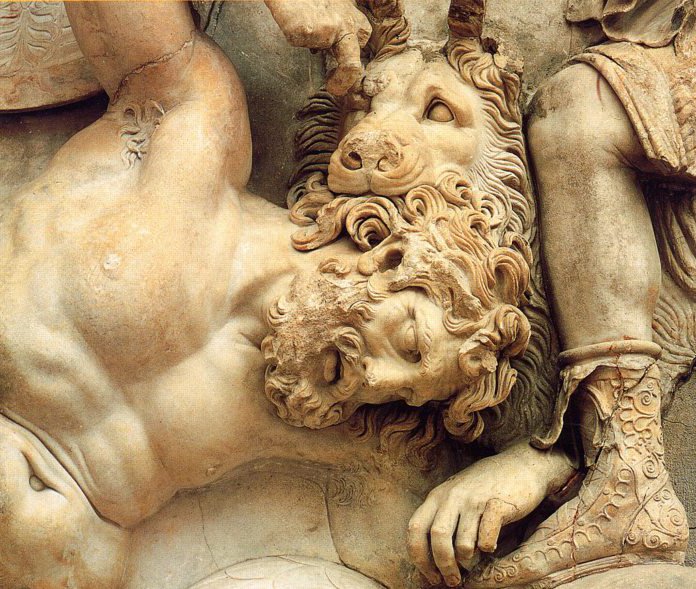
Detail
This impressive ceiling mural is the work of Giulio Romano, a former star pupil of Raphael. Some of his early works were important commissions for the Vatican, but in 1524, he was forced to flee from Rome for having designed some pornographic prints. Moving to Mantua, he became a favorite of the duke, for whom he produced architectural, engineering and artistic works. Here we see the battle of the Gods vs. the Giants, found at the Palazzo del Te in Mantua. The first image shows Zeus descending from his throne, thunderbolt in hand, ready to confront the rebellious giants below (second image), whose very foundations are crumbling at Zeus' approach. Romano is considered one of the founders of Mannerism, an important movement in the late Renaissance.

Romano 1

Romano 2
Zeus had one final opponent before he was truly the undisputed master of the universe—the being known as Typhon (or Typhoeus), a hideous dragon-serpent creature conceived through the mating of Gaea (Earth) and Tartarus (the Underworld). After a long and violent struggle, Zeus eventually defeated the fire-and-smoke-breathing monster. Their epic battle is seen here on a black-figure vase painting found in Etruria (northern Italy), but probably by a Greek artist, ca. 525 B.C.

Black Figure